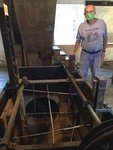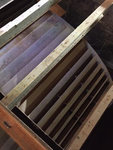

The Durham Grist Mill has had a partial facelift and was almost ready to show itself off to the public Saturday, but the continuing pandemic has put a stop to the special event.
It was to have featured tours of the mill by Ron Fox, a resident who worked there in the early 1960s after he had graduated from Palisades High School. In its final years, the mill was used to grind feed for animals but it had a long history of producing flour.
Durham Township officials and members of the Durham Historical Society had scheduled the event but as other municipalities announced cancellation after cancellation of other activities as COVID-19 numbers continued to rise, they decided to follow that cautious route as well.
“It’s a shame,” said Lois Oleksa, one of the directors of the society. “There’s so much history in this one place, three centuries of history. But there’s no reason we can’t have an open house at another date.”
The grist mill is built on the stone foundation of the 1727 blast furnace that provided ammunition for the Revolutionary War. Then William Long constructed his grist mill on the Colonial furnace’s foundation in 1820. In 1912, an adjoining warehouse was built.
The present complex also includes the township offices and meeting room, as well as the tiny Durham Post Office, said to be the second oldest in the country.
The mill was operated by Floyd Riegel until 1967. Bucks County bought the mill from Riegel and later sold it to Durham Township. It is listed on the Department of the Interior’s National Register of Historic Places.
I’ve been a frequent visitor to the mill over the years when lectures and workshops have taken place there and it’s never looked better than it does now.
David Oleksa, society president, and Stephen Willey, treasurer, pointed out some of the improvements. They were made possible with funds from a $53,000 state Department of Economic Development grant spearheaded by former state Rep. Wendy Ullman.
Join our readers whose generous donations are making it possible for you to read our news coverage. Help keep local journalism alive and our community strong. Donate today.